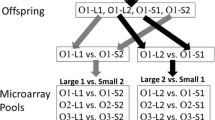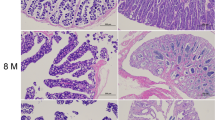Abstract
The present study evaluated the difference in the sex ratio (the genotypic and phenotypic female ratios) and the growth parameters between normal male offspring and neomale offspring under tank culture conditions. The phenotypic female ratio of normal male offspring (20.46–63.79 %) in four families and three stocks was remarkably higher than that of neomale offspring (5.21–10.53 %) in three neomale families and three neomale stocks (p < 0.01), while there was no significant difference between normal male offspring (30.41–70.60 %) and neomale offspring (29.7–70.83 %) in the genotypic female ratio (p > 0.05). The sex reversion ratio (SRR) was analyzed based on the genotypic and phenotypic female ratios. In neomale offspring, the SRR ranged from 84.25 to 92.53 %, while in normal offspring the SRR ranged from 9.65 to 34.60 %. There was a significant difference between normal male offspring and neomale offspring in the SRR (p < 0.01). The weight and length were measured at the ages of 300, 600, and 720 days. The growth rate was analyzed by the statistics, and there was a significant higher growth rate in the normal family than the neomale family (p < 0.05). The results suggest that the slower growth in the neomale offspring is responsible for the high SRR.
Similar content being viewed by others
Abbreviations
- SRR:
-
Sex reversion ratio
- AGRW:
-
Absolute growth rate of weight
References
Baroiller JF, D’Cotta H, Bezault E et al (2009) Tilapia sex determination: where temperature and genetics meet. Comp Biochem Physiol A Mol Integr Physiol 153:30–38
Basavaraja N, Nandeesha MC, Varghese TJ et al (1990) Induction of sex reversal in Oreochromis mossambicus by diethylstilbestrol. J Appl Ichthyol 6(1):46–50
Bhandari RK, Nakamura M, Kobayashi T et al (2006) Suppression of steroidogenic enzyme expression during androgen-induced sex reversal in Nile tilapia (Oreochromis niloticus). Gen Comp Endocrinol 145(1):20–24
Chakraborty SB, Banerjee S, Chatterjee S (2011) Increased androgen receptor expression in muscle tissue contributing to growth increase in androgen-treated Nile tilapia. Aquac Int 19:1119–1137
Chen SL, Li J, Deng SP et al (2007) Isolation of female-specific AFLP markers and molecular identification of genotypic sex in half-smooth tongue sole (Cynoglossus semilaevis). Mar Biotechnol 9(2):273–280
Chen SL, Deng SP, Ma HY et al (2008) Molecular marker-assisted sex control in half-smooth tongue sole (Cynoglossus semilaevis). Aquaculture 283:7–12
Chen SL, Tian YS, Yang JF et al (2009) Artificial gynogenesis and sex determination in half-smooth tongue sole (Cynoglossus semilaevis). Mar Biotechnol 11:243–251
Chen SL, Ji XS, Shao CW et al (2012) Induction of mitogynogenetic diploids and identification of WW Super-female using sex-specific SSR markers in half-smooth tongue sole (Cynoglossus semilaevis). Mar Biotechnol 14:120–128
Chen S, Zhang G, Shao C et al. (2014) Whole-genome sequence of a flatfish provides insights into ZW sex chromosome evolution and adaptation to benthic lifestyle. Nat Genet. doi:10.1038/ng.2890
Cheng CS, Chen LC (1990) Growth characteristics and relationships among body length, body weight and tail weight of Penaeus monodon from a culture environment in Taiwan. Aquaculture 91(3–4):253–263
Conover DO (2004) Temperature-dependent sex determination in fishes. In: Valenzuela N, Lance V (eds) Temperature-dependent sex determination in vertebrates. The American Naturalist, Chicago, pp 11–20
De Bock MS, López Greco LS (2010) Sex reversal and growth performance in juvenile females of the freshwater crayfish Cherax quadricarinatus (Parastacidae): effect of increasing temperature and androgenic gland extract in the diet. Aquac Int 18:231–243
Deng SP, Chen SL, Tian YS et al (2007) Gonadal differentiation and effects of temperature on sex determination in half-smooth tongue sole, Cynoglossus semilaevis. J Fish Sci China 14(5):714–719 (In Chinese abstract)
Deng SP, Chen SL, Xu JY et al (2009) Molecular cloning, characterization and expression analysis of gonadal P450aromatase in the half-smooth tongue-sole, Cynoglossus semilaevis. Aquaculture 287:211–218
Devlin RH, Nagahama Y (2002) Sex determination and sex differentiation in fish: an overview of genotype, phenotypeal, and environmental influences. Aquaculture 208:191–364
Fang JH, Tian XL, Dong SL (2010) The influence of water temperature and ration on the growth, body composition and energy budget of tongue sole (Cynoglossus semilaevis). Aquaculture 299:106–114
Gall GAE, Bakar Y (2002) Application of mixed-model techniques to fish breed improvement: analysis of breeding-value selection to increase 98-day body weight in tilapia. Aquaculture 212:93–113
Godwin J, Luckenbach JA, Borski RJ (2003) Ecology meets endocrinology: environmental sex determination in fishes. Evol Dev 5(1):40–49
Green BW, Teichert-Coddington DR (1993) Production of Oreochromis niloticus fry for hormonal sex reversal in relation to water temperature. J Appl Ichthyol 9:230–236
Hattori RS, Fernandino JI, Kishii A et al (2009) Cortisol-induced masculinization: does thermal stress affect gonadal fate in pejerrey, a teleost fish with temperature-dependent sex determination? PLoS One 4(8):e6548
Hulak M, Paroulek M, Silmek P et al (2008) Water polluted by 17α-methyltestosterone provides successful male sex inversion of common carp (Cyprinus carpio L.) from gyno genotype offspring. J Appl Ichthyol 24:707–710
Janhunen M, Kause A, Mäntysaari EA et al. (2013) A novel breeding design to produce genetically protected homogenous fish populations for on-growing. Aquac Res 44(12):1847–1859
Komen J, Bongers ABJ, Richter CJJ (1991) Gynogenesis in common carp Cyprinus carpio: II. The production of homozygous gyno genotype clones and F1 hybrids. Aquaculture 92:127–142
Liu J, Morgan M, Hutchison K et al (2010) A Study of the influence of sex on genome wide methylation. PLoS One 5(4):e10028
Navarro-MartÍn L, Vinas J, Ribas L et al (2011) DNA methylation of the gonadal aromatase (cyp19a) promoter is involved in temperature-dependent sex ratio shifts in the European Sea Bass. PLoS Genet 7:e1002447
Nomura T, Arai K, Hayashi T et al (1998) Effect of temperature on sex rations of normal and gyno genotype diploid loach. Fish Sci 64:753–758
Oldfield RG (2005) Genotype, abiotic and social influences on sex differentiation in cichlid fishes and the evolution of sequential hermaphroditism. Fish Fish 6(2):93–110
Ospina-Álvarez N, Piferrer F (2008) Temperature-dependent sex determination in fish revisited: prevalence, a single sex ratio response pattern, and possible effects of climate change. PLoS One 3:e2837
Shao C, Li Q, Chen S et al. (2014) Epigenetic modification and inheritance in sexual reversal of fish. Genome Res. doi:10.1101/gr.162172.113
Smith ES, Phelps RP (2001) Impact of feed storage conditions on growth and efficacy of sex reversal of Nile tilapia. N Am J Aquac 63(3):242–245
Sokal RR, Rohlf FJ (1981) Biometry: the principles and practice of statistics in biological research. W.H. Freeman, San Francisco, p 859
Valenzuela N, Adams DC, Janzen FJ (2003) Pattern does not equal process: exactly when is sex environmentally determined? Am Nat 161(4):676–683
Yamamoto T, Kajishima T (1968) Sex hormone induction of sex reversal in the goldfish and evidence for male heterogamity. J Exp Zool 168(2):215–222
Zhang W (2010) The impact of water temperature and underground deep well water on the Cynoglossus semilaevis growth. Dissertation, Ocean University of China
Acknowledgments
This study was supported by grants from State 863 High-Technology R&D Project of China (2012AA10A403-2, 2012AA092203) Special Fund for Agro-scientific Research in the Public interest (200903046), National Nature Science Foundation of China (31130057, 31072202), Taishan Scholar Project Fund of Shandong of China and The National Nature Science Foundation for Young Scholar (41006107).
Author information
Authors and Affiliations
Corresponding author
Rights and permissions
About this article
Cite this article
Hu, Q., Chen, SL., Gao, F. et al. Differences in sex reversion and growth between normal and neomale stock in half-smooth tongue sole, Cynoglossus semilaevis . Aquacult Int 22, 1437–1449 (2014). https://doi.org/10.1007/s10499-014-9757-7
Received:
Accepted:
Published:
Issue Date:
DOI: https://doi.org/10.1007/s10499-014-9757-7




